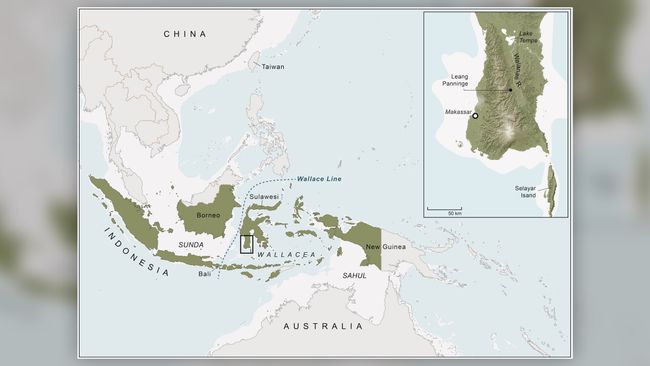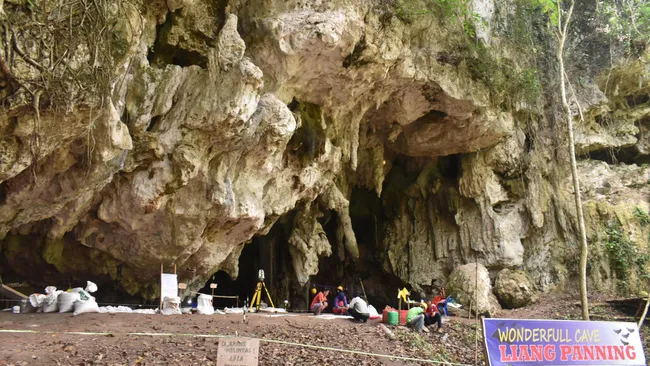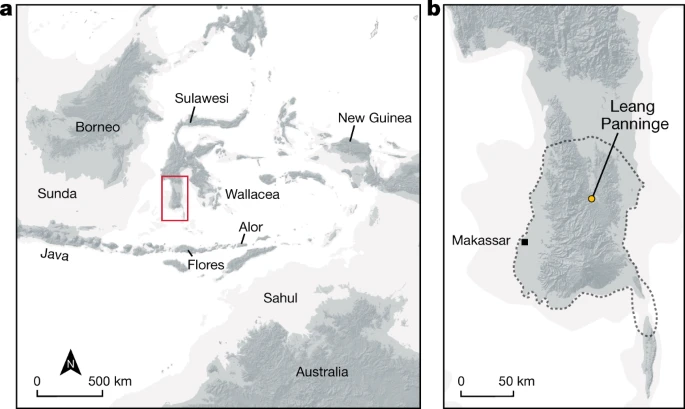Post by Admin on Aug 25, 2021 4:45:43 GMT
Results
Distinct Population Stratification across the Philippines Reveals Multiple Ancestral Sources.
Investigation by principal component analysis (PCA) demonstrates that all Philippine ethnic groups cluster together with Asia-Pacific populations in a global comparison (Fig. 1B and SI Appendix, Fig. S1 B and C). While Negritos form a distinctive cline that aligns between Papuans and non-Negritos, Cordillerans interestingly lie to the edge that defines the East Asian cluster on principal component (PC) 1, even more extreme than Native American groups and Oceanian groups (Fig. 1B). There is a clear dichotomy between Negritos and non-Negritos, indicating the deep divergence between Basal East Asian ancestry best represented by Cordillerans and Basal Australasian ancestry represented by Negrito-AustraloPapuans (Fig. 1B and SI Appendix, Fig. S1 B and C). Looking into the fine-scale analysis of Asia-Pacific populations, non-Negritos clearly separate into groups either affiliated with Cordillerans or with Mainland Southeast Asia (MSEA) ethnic groups (such as Htin and Mlabri, or Malay non-Negritos) (SI Appendix, Fig. S1 D–G).
Further analyses reveal distinct genetic structure among Philippine Negrito groups, as will be described later, and stratification among non-Negrito groups, exemplified by Cordillerans, Mangyans, Manobos, and Sama Dilaut groups (Fig. 1 C and D). These observations are consistent with inferred ancestry components (SI Appendix, Fig. S2 B–D). Briefly, stratification commences with a dichotomy between AustraloPapuan-related Negritos vs. non-Negritos, subsequent clustering of non-Negritos into Cordilleran vs. MSEA-affiliated populations, and stratification of Negritos into Ayta and Agta groups and non-Negritos into Cordilleran, Mangyan, Manobo, and Sama-related populations.
Philippine Negritos Exhibit Deep Divergences.
Given the geographical barriers and the likely long history of isolation between populations, some degree of differentiation is expected among Negrito groups. For instance, PCA restricted to Negrito groups reveals a gradient between Central Luzon Negrito groups and Southern Negrito groups (PC1), and an east-to-west clustering of Negritos in the northern Philippines along PC2 (SI Appendix, Fig. S4A). The Northern Negritos additionally exhibit deep population structure, separating into three clusters: Central Luzon Negritos (all Ayta Negritos), Southeastern Luzon Negritos (Agta groups of Bicol region and Quezon province), and Northeast Luzon Negritos (Agta, Atta, and Arta Negritos of Cagayan region) (SI Appendix, Fig. S4B).
Negritos of the northern Philippines are an outgroup to both Australians and Papuans (Fig. 2A and SI Appendix, Figs. S4 D, E, G–I and S5D). Using a coalescent-based split-time estimation approach and assuming a population divergence model (12, 13), we estimate the ancestors of Negritos of the northern Philippines to have diverged ∼46 kya (95% CI: 45.5 to 46.8 kya) from a common ancestral Australasian population (Basal Sunda). The divergence likely happened in the old continental landmass of Sundaland, prior to the Australian-Papuan divergence ∼25 kya (95% CI: 24.7 to 26.7 kya), possibly as a consequence of migration into Luzon to become present-day Negritos of the northern Philippines (SI Appendix, Figs. S4J and S5D).

Fig. 2.
Inferred admixture graph models for Australasians and East Asians. Inferred admixture graph models based on a combination of qpGraph and f statistical analyses presented in SI Appendix, Figs. S4–S8. (A) Topology of Australasian cluster indicating pulses of Denisovan introgression events, and estimation of divergence time between Philippine Negritos and AustraloPapuans. (B) Topology of the East Asian cluster showing relationships between Cordillerans, Manobo, Sama, and mainland Asian ethnic groups with inferred admixture events and divergence dates. See main text for divergence time confidence intervals.
In contrast to the north, the AustraloPapuan-like genetic signal is distinctively higher in Southern Negritos (e.g., Mamanwa) than in other Negrito groups (Fig. 2A and SI Appendix, Fig. S4 K–M). The Mamanwa Negritos also appear as an outgroup to Papuans and Australians (SI Appendix, section 4.3), indicating that the ancestral Mamanwa is an offshoot group of Basal Oceanian that diverged ∼37 kya (95% CI: 36.2 to 38.7 kya), by which entered Mindanao Island, likely via the Sulu Archipelago, prior to the Australian-Papuan divergence (Fig. 2A and SI Appendix, Figs. S4J and S5D). However, an alternative model where Southern Negritos form a clade with Northern Negritos is not rejected (SI Appendix, section 4.3 and Fig. S5G). Given this, we are unable to exclude a scenario where a common ancestral Negrito population entered the Philippines exclusively through a single port of entry, either via Palawan or via the Sulu archipelago, and subsequently diverged within the Philippines to become the Northern and Southern Negritos.
Both Northern and Southern Negritos subsequently admixed with Cordilleran-related populations, and, interestingly, Southern Negritos received an additional gene flow from Papuan-related populations after Australian-Papuan divergence (SI Appendix, Fig. S5 D and G). This previously unappreciated northwest gene flow of Papuan-related ancestry had its greatest impact on eastern Indonesia, as well as ethnic groups of the southeastern Philippines, such as Sangil and Blaan (SI Appendix, section 4.5).
Ancestral Manobos and Ancestral Sama Entered the Southern Philippines Earlier Than the Expansion of Cordilleran-Related Populations.
The ethnic groups of the southern Philippines exhibit a ubiquitous ancestry that is non–AustraloPapuan-related and which is generally absent among non-Negrito groups of the northern Philippines. This unique genetic signature, heretofore designated as “Manobo ancestry,” is highest among inland Manobo groups of Mindanao Island (SI Appendix, Fig. S6A). When we masked Cordilleran and Southern Negrito ancestry and retained only the Manobo ancestry, the Manobo component became more apparent among other ethnic groups of Mindanao (SI Appendix, Fig. S6B). In addition to Manobo ancestry, another distinct ancestry was identified in the southwestern Philippines. This genetic signal is highest among Sama sea nomads of the Sulu Archipelago and is designated as “Sama ancestry” (SI Appendix, Fig. S6G). When we mask all other ancestries and retain only Sama ancestry, the Sama component becomes more evident among ethnic groups of Zamboanga Peninsula, Palawan, Basilan, Sulu, and Tawi-Tawi islands, even among populations who do not self-identify as Sama or speak a Sama-related language (SI Appendix, Fig. S6H).
Ethnic groups with high Sama ancestry exhibit significantly higher genetic affiliation with Austroasiatic-speaking ethnic groups of MSEA, such as Mlabri and Htin, relative to the least admixed Manobo group, Manobo Ata (SI Appendix, Figs. S6K and S7 A–D, J, and K). This Htin/Mlabri-related genetic signal is not only found in Sama Dilaut and inland Sama groups, but also in Palawanic and Zamboanga peninsula ethnic groups of the southwestern Philippines. These findings are consistent with previous observations where a Htin/Mlabri-related genetic signal was detected among ethnic groups of western Indonesia (10). In our analysis, we find that this genetic signal also extends beyond western Indonesia and into the southwestern Philippines.
Both Manobo and Sama genetic ancestries diverge from a common East Asian ancestral gene pool (∼15 kya [95% CI: 14.8 to 15.4 kya]) earlier than the estimated divergence between the indigenous peoples of Taiwan and Cordillerans (Fig. 2B and SI Appendix, Fig. S7E). Surprisingly, both of these ancestries (Manobo and Sama) diverged from the common East Asian branch before Han, Dai, and Kinh split from Amis, Atayal, or Cordillerans (Fig. 2B and SI Appendix, Figs. S6 E, F, and L). Hence, our findings indicate that Ancestral Manobo and Ancestral Sama, together with other Htin/Mlabri-related ethnic groups, form a branch that diverged from Basal East Asians ∼15 kya even before the expansion of Han, Dai, Japanese, Kinh, Amis, and Atayal (Fig. 2B and SI Appendix, Figs. S6 E, F, and L and S7E).
Sama forms a clade with Htin relative to Manobo Ata (SI Appendix, Fig. S7 A–D and sections 5.5 and 5.6). The common ancestor of Sama and Htin/Mlabri populations was estimated to have diverged from Ancestral Manobo ∼12 kya (95% CI: 11.4 to 12.6 kya). Given the geographic distribution of the Htin/Mlabri-related genetic signal today, their ancestors likely expanded into western Indonesia and the southwestern Philippines, via Sundaland, before the expansion of Cordilleran-related populations (14). Interestingly, the above estimated divergences (15 kya and 12 kya) coincide with the major geological changes in ISEA, inferred from reconstructions of Sundaland at the end of the Last Glacial Period (SI Appendix, Fig. S3 E and F). Accordingly, climate-driven changes in ISEA may have prompted postglacial movements and isolation of populations, which led to the differentiation of ethnic groups in the region.
Distinct Population Stratification across the Philippines Reveals Multiple Ancestral Sources.
Investigation by principal component analysis (PCA) demonstrates that all Philippine ethnic groups cluster together with Asia-Pacific populations in a global comparison (Fig. 1B and SI Appendix, Fig. S1 B and C). While Negritos form a distinctive cline that aligns between Papuans and non-Negritos, Cordillerans interestingly lie to the edge that defines the East Asian cluster on principal component (PC) 1, even more extreme than Native American groups and Oceanian groups (Fig. 1B). There is a clear dichotomy between Negritos and non-Negritos, indicating the deep divergence between Basal East Asian ancestry best represented by Cordillerans and Basal Australasian ancestry represented by Negrito-AustraloPapuans (Fig. 1B and SI Appendix, Fig. S1 B and C). Looking into the fine-scale analysis of Asia-Pacific populations, non-Negritos clearly separate into groups either affiliated with Cordillerans or with Mainland Southeast Asia (MSEA) ethnic groups (such as Htin and Mlabri, or Malay non-Negritos) (SI Appendix, Fig. S1 D–G).
Further analyses reveal distinct genetic structure among Philippine Negrito groups, as will be described later, and stratification among non-Negrito groups, exemplified by Cordillerans, Mangyans, Manobos, and Sama Dilaut groups (Fig. 1 C and D). These observations are consistent with inferred ancestry components (SI Appendix, Fig. S2 B–D). Briefly, stratification commences with a dichotomy between AustraloPapuan-related Negritos vs. non-Negritos, subsequent clustering of non-Negritos into Cordilleran vs. MSEA-affiliated populations, and stratification of Negritos into Ayta and Agta groups and non-Negritos into Cordilleran, Mangyan, Manobo, and Sama-related populations.
Philippine Negritos Exhibit Deep Divergences.
Given the geographical barriers and the likely long history of isolation between populations, some degree of differentiation is expected among Negrito groups. For instance, PCA restricted to Negrito groups reveals a gradient between Central Luzon Negrito groups and Southern Negrito groups (PC1), and an east-to-west clustering of Negritos in the northern Philippines along PC2 (SI Appendix, Fig. S4A). The Northern Negritos additionally exhibit deep population structure, separating into three clusters: Central Luzon Negritos (all Ayta Negritos), Southeastern Luzon Negritos (Agta groups of Bicol region and Quezon province), and Northeast Luzon Negritos (Agta, Atta, and Arta Negritos of Cagayan region) (SI Appendix, Fig. S4B).
Negritos of the northern Philippines are an outgroup to both Australians and Papuans (Fig. 2A and SI Appendix, Figs. S4 D, E, G–I and S5D). Using a coalescent-based split-time estimation approach and assuming a population divergence model (12, 13), we estimate the ancestors of Negritos of the northern Philippines to have diverged ∼46 kya (95% CI: 45.5 to 46.8 kya) from a common ancestral Australasian population (Basal Sunda). The divergence likely happened in the old continental landmass of Sundaland, prior to the Australian-Papuan divergence ∼25 kya (95% CI: 24.7 to 26.7 kya), possibly as a consequence of migration into Luzon to become present-day Negritos of the northern Philippines (SI Appendix, Figs. S4J and S5D).

Fig. 2.
Inferred admixture graph models for Australasians and East Asians. Inferred admixture graph models based on a combination of qpGraph and f statistical analyses presented in SI Appendix, Figs. S4–S8. (A) Topology of Australasian cluster indicating pulses of Denisovan introgression events, and estimation of divergence time between Philippine Negritos and AustraloPapuans. (B) Topology of the East Asian cluster showing relationships between Cordillerans, Manobo, Sama, and mainland Asian ethnic groups with inferred admixture events and divergence dates. See main text for divergence time confidence intervals.
In contrast to the north, the AustraloPapuan-like genetic signal is distinctively higher in Southern Negritos (e.g., Mamanwa) than in other Negrito groups (Fig. 2A and SI Appendix, Fig. S4 K–M). The Mamanwa Negritos also appear as an outgroup to Papuans and Australians (SI Appendix, section 4.3), indicating that the ancestral Mamanwa is an offshoot group of Basal Oceanian that diverged ∼37 kya (95% CI: 36.2 to 38.7 kya), by which entered Mindanao Island, likely via the Sulu Archipelago, prior to the Australian-Papuan divergence (Fig. 2A and SI Appendix, Figs. S4J and S5D). However, an alternative model where Southern Negritos form a clade with Northern Negritos is not rejected (SI Appendix, section 4.3 and Fig. S5G). Given this, we are unable to exclude a scenario where a common ancestral Negrito population entered the Philippines exclusively through a single port of entry, either via Palawan or via the Sulu archipelago, and subsequently diverged within the Philippines to become the Northern and Southern Negritos.
Both Northern and Southern Negritos subsequently admixed with Cordilleran-related populations, and, interestingly, Southern Negritos received an additional gene flow from Papuan-related populations after Australian-Papuan divergence (SI Appendix, Fig. S5 D and G). This previously unappreciated northwest gene flow of Papuan-related ancestry had its greatest impact on eastern Indonesia, as well as ethnic groups of the southeastern Philippines, such as Sangil and Blaan (SI Appendix, section 4.5).
Ancestral Manobos and Ancestral Sama Entered the Southern Philippines Earlier Than the Expansion of Cordilleran-Related Populations.
The ethnic groups of the southern Philippines exhibit a ubiquitous ancestry that is non–AustraloPapuan-related and which is generally absent among non-Negrito groups of the northern Philippines. This unique genetic signature, heretofore designated as “Manobo ancestry,” is highest among inland Manobo groups of Mindanao Island (SI Appendix, Fig. S6A). When we masked Cordilleran and Southern Negrito ancestry and retained only the Manobo ancestry, the Manobo component became more apparent among other ethnic groups of Mindanao (SI Appendix, Fig. S6B). In addition to Manobo ancestry, another distinct ancestry was identified in the southwestern Philippines. This genetic signal is highest among Sama sea nomads of the Sulu Archipelago and is designated as “Sama ancestry” (SI Appendix, Fig. S6G). When we mask all other ancestries and retain only Sama ancestry, the Sama component becomes more evident among ethnic groups of Zamboanga Peninsula, Palawan, Basilan, Sulu, and Tawi-Tawi islands, even among populations who do not self-identify as Sama or speak a Sama-related language (SI Appendix, Fig. S6H).
Ethnic groups with high Sama ancestry exhibit significantly higher genetic affiliation with Austroasiatic-speaking ethnic groups of MSEA, such as Mlabri and Htin, relative to the least admixed Manobo group, Manobo Ata (SI Appendix, Figs. S6K and S7 A–D, J, and K). This Htin/Mlabri-related genetic signal is not only found in Sama Dilaut and inland Sama groups, but also in Palawanic and Zamboanga peninsula ethnic groups of the southwestern Philippines. These findings are consistent with previous observations where a Htin/Mlabri-related genetic signal was detected among ethnic groups of western Indonesia (10). In our analysis, we find that this genetic signal also extends beyond western Indonesia and into the southwestern Philippines.
Both Manobo and Sama genetic ancestries diverge from a common East Asian ancestral gene pool (∼15 kya [95% CI: 14.8 to 15.4 kya]) earlier than the estimated divergence between the indigenous peoples of Taiwan and Cordillerans (Fig. 2B and SI Appendix, Fig. S7E). Surprisingly, both of these ancestries (Manobo and Sama) diverged from the common East Asian branch before Han, Dai, and Kinh split from Amis, Atayal, or Cordillerans (Fig. 2B and SI Appendix, Figs. S6 E, F, and L). Hence, our findings indicate that Ancestral Manobo and Ancestral Sama, together with other Htin/Mlabri-related ethnic groups, form a branch that diverged from Basal East Asians ∼15 kya even before the expansion of Han, Dai, Japanese, Kinh, Amis, and Atayal (Fig. 2B and SI Appendix, Figs. S6 E, F, and L and S7E).
Sama forms a clade with Htin relative to Manobo Ata (SI Appendix, Fig. S7 A–D and sections 5.5 and 5.6). The common ancestor of Sama and Htin/Mlabri populations was estimated to have diverged from Ancestral Manobo ∼12 kya (95% CI: 11.4 to 12.6 kya). Given the geographic distribution of the Htin/Mlabri-related genetic signal today, their ancestors likely expanded into western Indonesia and the southwestern Philippines, via Sundaland, before the expansion of Cordilleran-related populations (14). Interestingly, the above estimated divergences (15 kya and 12 kya) coincide with the major geological changes in ISEA, inferred from reconstructions of Sundaland at the end of the Last Glacial Period (SI Appendix, Fig. S3 E and F). Accordingly, climate-driven changes in ISEA may have prompted postglacial movements and isolation of populations, which led to the differentiation of ethnic groups in the region.




